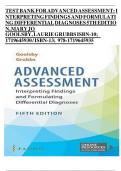TEST BANK FOR ADVANCED ASSESSMENT: I
9 9 9 9 9
NTERPRETING FINDINGS AND FORMULATI
9 9 9
NG DIFFERENTIAL DIAGNOSES 5TH EDITIO
9 9 9 9
N, MARY JO
9 9 9
GOOLSBY, LAURIE GRUBBS ISBN-10;
9 9 9
1719645930 / ISBN-13; 978-1719645935
9 9
,Chapter9 1.9 Assessment9 and9 Clinical9 Decision-Making:9 Overview
Multiple9Choice
Identify9the9choice9that9best9completes9the9statement9or9answers9the9question.
9 1. Which9type9of9clinical9decision-making9is9most9reliable?
A. Intuitive
B. Analytical
C. Experiential
D. Augenblick
9 2. Which9of9the9following9is9false?9To9obtain9adequate9history,9health-care9providers9must9be:
A. Methodical9and9systematic
B. Attentive9to9the9patient’s9verbal9and9nonverbal9language
C. Able9to9accurately9interpret9the9patient’s9responses
D. Adept9at9reading9into9the9patient’s9statements
9 3. Essential9parts9of9a9health9history9include9all9of9the9following9except:
A. Chief9complaint
B. History9of9the9present9illness
C. Current9vital9signs
D. All9of9the9above9are9essential9history9components
9 4. Which9of9the9following9is9false?9While9performing9the9physical9examination,9the9examiner9must9be9
able9to:
A. Differentiate9between9normal9and9abnormal9findings
B. Recall9knowledge9of9a9range9of9conditions9and9their9associated9signs9and9symptoms
C. Recognize9how9certain9conditions9affect9the9response9to9other9conditions
D. Foresee9unpredictable9findings
9 5. The9following9is9the9least9reliable9source9of9information9for9diagnostic9statistics:
A. Evidence-based9investigations
B. Primary9reports9of9research
C. Estimation9based9on9a9provider’s9experience
D. Published9meta-analyses
9 6. The9following9can9be9used9to9assist9in9sound9clinical9decision-making:
A. Algorithm9published9in9a9peer-reviewed9journal9article
B. Clinical9practice9guidelines
C. Evidence-based9research
D. All9of9the9above
9 7. If9a9diagnostic9study9has9high9sensitivity,9this9indicates9a:
A. High9percentage9of9persons9with9the9given9condition9will9have9an9abnormal9result
B. Low9percentage9of9persons9with9the9given9condition9will9have9an9abnormal9result
C. Low9likelihood9of9normal9result9in9persons9without9a9given9condition
D. None9of9the9above
,9 8. If9a9diagnostic9study9has9high9specificity,9this9indicates9a:
A. Low9percentage9of9healthy9individuals9will9show9a9normal9result
B. High9percentage9of9healthy9individuals9will9show9a9normal9result
C. High9percentage9of9individuals9with9a9disorder9will9show9a9normal9result
D. Low9percentage9of9individuals9with9a9disorder9will9show9an9abnormal9result
9 9. A9likelihood9ratio9above919indicates9that9a9diagnostic9test9showing9a:
A. Positive9result9is9strongly9associated9with9the9disease
B. Negative9result9is9strongly9associated9with9absence9of9the9disease
C. Positive9result9is9weakly9associated9with9the9disease
D. Negative9result9is9weakly9associated9with9absence9of9the9disease
9 999 10.9Which9of9the9following9clinical9reasoning9tools9is9defined9as9evidence-
based9resource9based9on9mathematical9modeling9to9express9the9likelihood9of9a9condition9in9select9s
ituations,9settings,9and/or9patients?
A. Clinical9practice9guideline
B. Clinical9decision9rule
C. Clinical9algorithm
D. Clinical9recommendation
, Answer9Section
MULTIPLE9CHOICE
1. ANS:9 B
Croskerry9(2009)9describes9two9major9types9of9clinical9diagnostic9decision-
making:9intuitive9and9analytical.9Intuitive9decision-making9(similar9to9Augenblink9decision-
making)9is9based9on9the9experience9and9intuition9of9the9clinician9and9is9less9reliable9and9paired9wit
h9fairly9common9errors.9In9contrast,9analytical9decision-
making9is9based9on9careful9consideration9and9has9greater9reliability9with9rare9errors.
PTS: 1
2. ANS:9 D
To9obtain9adequate9history,9providers9must9be9well9organized,9attentive9to9the9patient’s9verbal9and9n
onverbal9language,9and9able9to9accurately9interpret9the9patient’s9responses9to9questions.9Rather9tha
n9reading9into9the9patient’s9statements,9they9clarify9any9areas9of9uncertainty.
PTS: 1
3. ANS:9 C
Vital9signs9are9part9of9the9physical9examination9portion9of9patient9assessment,9not9part9of9the9health9his
tory.
PTS: 1
4. ANS:9 D
While9performing9the9physical9examination,9the9examiner9must9be9able9to9differentiate9between9nor
mal9and9abnormal9findings,9recall9knowledge9of9a9range9of9conditions,9including9their9associated9si
gns9and9symptoms,9recognize9how9certain9conditions9affect9the9response9to9other9conditions,9and9d
istinguish9the9relevance9of9varied9abnormal9findings.
PTS: 1
5. ANS:9 C
Sources9for9diagnostic9statistics9include9textbooks,9primary9reports9of9research,9and9published9me
ta-
analyses.9Another9source9of9statistics,9the9one9that9has9been9most9widely9used9and9available9for9a
pplication9to9the9reasoning9process,9is9the9estimation9based9on9a9provider’s9experience,9although9t
hese9are9rarely9accurate.9Over9the9past9decade,9the9availability9of9evidence9on9which9to9base9clini
cal9reasoning9is9improving,9and9there9is9an9increasing9expectation9that9clinical9reasoning9be9based9
on9scientific9evidence.9Evidence-
based9statistics9are9also9increasingly9being9used9to9develop9resources9to9facilitate9clinical9decision
-making.
PTS: 1
6. ANS:9 D
To9assist9in9clinical9decision-making,9a9number9of9evidence-
based9resources9have9been9developed9to9assist9the9clinician.9Resources,9such9as9algorithms9and9clin
ical9practice9guidelines,9assist9in9clinical9reasoning9when9properly9applied.




